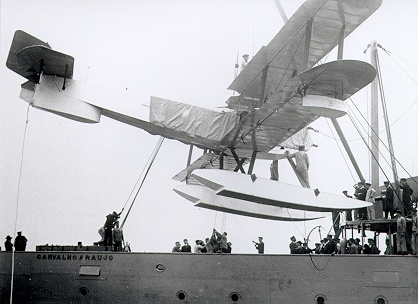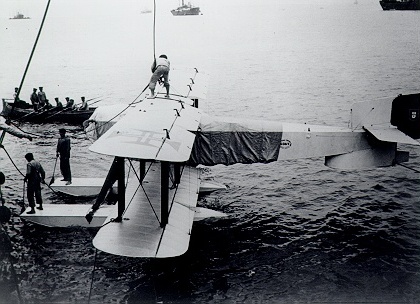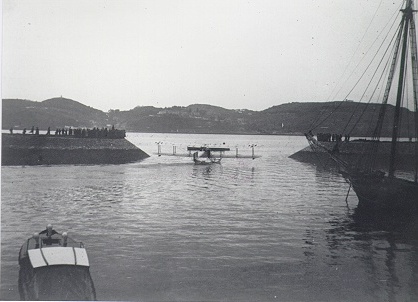Details of the trip: edited excerpts from the aviators’ writings (by Armand F. Pereira)
 Fernando Noronha- Recife: On 2 June the third Fairey 17 named
"Santa Cruz" (see photos) arrived on the Navy ship Carvalho Araujo. Unlike the
Fairey Lusitania, which had been designed especially for a southern Atlantic crossing
without sea landing accidents, this Fairey had a smaller fuel capacity of 102 gallons
which enabled to fly up to 7.5 hours. On 5 June, it took off at 8:48 reaching the southern
tip of the island at 8:55 with a 12 mile SE wind which drifted the hydroplane some 10
degrees . By 9:15, land was out of sight and the Fairey maintained 90 ft at some 65 miles
of real speed per hour. At 9:27 and 9:51 the Santa Cruz flew over ships that transmitted
messages to the Republica, now anchored in Recife waiting for the Santa Cruz to arrive.
The ride got shakier and the Fairey climbed to 1,800 ft. Some rain spells emerged ahead
and the way to avoid them was to climb to 5,000 ft through some isolated
"cumulos" (CBs or other Cs?). At 11:40, what seemed to be a white line turned
out gradually to be a beach in the Brazilian coast line. The course was changed slightly
to reach it as quickly as possible.
Fernando Noronha- Recife: On 2 June the third Fairey 17 named
"Santa Cruz" (see photos) arrived on the Navy ship Carvalho Araujo. Unlike the
Fairey Lusitania, which had been designed especially for a southern Atlantic crossing
without sea landing accidents, this Fairey had a smaller fuel capacity of 102 gallons
which enabled to fly up to 7.5 hours. On 5 June, it took off at 8:48 reaching the southern
tip of the island at 8:55 with a 12 mile SE wind which drifted the hydroplane some 10
degrees . By 9:15, land was out of sight and the Fairey maintained 90 ft at some 65 miles
of real speed per hour. At 9:27 and 9:51 the Santa Cruz flew over ships that transmitted
messages to the Republica, now anchored in Recife waiting for the Santa Cruz to arrive.
The ride got shakier and the Fairey climbed to 1,800 ft. Some rain spells emerged ahead
and the way to avoid them was to climb to 5,000 ft through some isolated
"cumulos" (CBs or other Cs?). At 11:40, what seemed to be a white line turned
out gradually to be a beach in the Brazilian coast line. The course was changed slightly
to reach it as quickly as possible.  At 11:58, the aircraft passed the Manranguan river, at 12:12 in
front of the town of Joao Pessoa, Paraiba and at 12:20 in front of Cabo Branco (the
eastern most point of the Americas). The Santa Cruz continued along the coast and overflew
the town of Olinda at 13:11, landing at 13:20 in the port of Recife after a circle over
the city to look at the numerous fireworks announcing their arrival. The Santa Cruz had
travelled 300 miles from Fernando Noronha in 4.5 hours at 67 miles per hour. "The
southern Atlantic crossing was thus completed." On 6-7 June, the aviators indulged in
local celebrations while waiting for the cruiser Carvalho Araujo to reach Salvador da
Bahia (the Republica sailed later to Salvador and Porto Seguro).
At 11:58, the aircraft passed the Manranguan river, at 12:12 in
front of the town of Joao Pessoa, Paraiba and at 12:20 in front of Cabo Branco (the
eastern most point of the Americas). The Santa Cruz continued along the coast and overflew
the town of Olinda at 13:11, landing at 13:20 in the port of Recife after a circle over
the city to look at the numerous fireworks announcing their arrival. The Santa Cruz had
travelled 300 miles from Fernando Noronha in 4.5 hours at 67 miles per hour. "The
southern Atlantic crossing was thus completed." On 6-7 June, the aviators indulged in
local celebrations while waiting for the cruiser Carvalho Araujo to reach Salvador da
Bahia (the Republica sailed later to Salvador and Porto Seguro).
Recife- Bahia: On 8 June, Coutinho and Cabral took off at 8:53 with good weather and SE and E winds all the way. They reached the Cabo de Santo Agostinho lighthouse at 9:23, Tamandare lighthouse at 9:43, Ponta de Maceio at 10:23, Barra do Rio Sao Francisco at 11:44, Aracaju at 12:20, and Salvador da Bahia at 14:28 where a huge crowd awaited them on the docks and in ships. The trip from Recife took 5.5 hours at 69 miles an hour.
 Bahia-Porto Seguro: The airmen stayed in Bahia until 13 June
waiting for bad weather to pass (or so they say!...). On 13 June, the aircraft was ready
for take off at 7:16 with gasoline for 8.5 hours, including an hour’s worth in cans
(since the tank of the Santa Cruz only allowed them to fly 7.5 hours). The first two
attempts to take off were unsuccessful due to excessive weight and unfavourable wind
conditions. The aircraft was finally airborne with great strain at 7:30, and suddenly
Cabral noticed that two cables connecting the wings to the floaters had broken off (the
same had happened on arrival at Las Palmas). This incident should have been enough to make
them turn back, but their motivation to reach final destination as quickly as possible
made them overlook the risks involved. Struggling against strong SSE winds and with a
speed below 50 miles an hour, the aircraft managed to reach Morro de Sao Paulo at 8:05. At
9:43, the airmen decided to circle Sao Jorge dos Ilheus in response to the fireworks
welcoming their passage. They reached Olivenca at 9:53 and Monte Pascoal (Pedro Alvares de
Cabral’s landmark in his maiden voyage of 1500) at 10:56. As the weather improved,
speed increased and the Santa Cruz reached Santo Antonio at 11:17, Santa Cruz at 11:17 and
Porto Seguro at 11:30 with some 4 hours of fuel left in the tank. The next day was used to
repair the cables of the hydroplane and to visit the historical sites in memory of
Cabral’s discovery of Brazil.
Bahia-Porto Seguro: The airmen stayed in Bahia until 13 June
waiting for bad weather to pass (or so they say!...). On 13 June, the aircraft was ready
for take off at 7:16 with gasoline for 8.5 hours, including an hour’s worth in cans
(since the tank of the Santa Cruz only allowed them to fly 7.5 hours). The first two
attempts to take off were unsuccessful due to excessive weight and unfavourable wind
conditions. The aircraft was finally airborne with great strain at 7:30, and suddenly
Cabral noticed that two cables connecting the wings to the floaters had broken off (the
same had happened on arrival at Las Palmas). This incident should have been enough to make
them turn back, but their motivation to reach final destination as quickly as possible
made them overlook the risks involved. Struggling against strong SSE winds and with a
speed below 50 miles an hour, the aircraft managed to reach Morro de Sao Paulo at 8:05. At
9:43, the airmen decided to circle Sao Jorge dos Ilheus in response to the fireworks
welcoming their passage. They reached Olivenca at 9:53 and Monte Pascoal (Pedro Alvares de
Cabral’s landmark in his maiden voyage of 1500) at 10:56. As the weather improved,
speed increased and the Santa Cruz reached Santo Antonio at 11:17, Santa Cruz at 11:17 and
Porto Seguro at 11:30 with some 4 hours of fuel left in the tank. The next day was used to
repair the cables of the hydroplane and to visit the historical sites in memory of
Cabral’s discovery of Brazil.
Porto Seguro-Vitoria: On 15 June, the aircraft took off at 7:55 under a clear sky and a calm sea, enabling a view of Monte Pascoal as far as 90 miles away from Porto Seguro. By 8:15, however, a change of fuel tanks caused some engine hiccups, but not for long and, without further incidents, the Santa Cruz reached Prado at 8:45, Caravelas at 9:07, Barra do Rio Doce at 10:48 and Vitoria at 11:30, landing at 11:35 again under more fireworks close to the Carvalho Araujo that waited in the bay.
Vitoria-Rio de Janeiro: This last stretch began at 9:42 on 17 June. With 6 hours of fuel in its tanks, the Fairey climbed to 1000 ft with a bit of shaking resulting from the abrupt topography surrounding the bay area. The aircraft aimed at the coast line struggling against a 12 mile southerly wind which kept speed at 52-55 miles an hour. It reached Benavente at 10:30, Itabapuana at 11:24 and Barra do Paraiba at 11:24 and Sao Tome at 11:47. Wide rains with clouds and fog emerged in the meantime without any options to avoid them, forcing the aviators to descend below 150 feet to keep the sight of the beach line. The rain stopped at 12:15 and the aeroplane gained some altitude, reaching the Santa Ana islet at 12:40 and Cabo Frio at 13:16, turning slightly west to fly above the lakes along the coast (presumably in what is currently the Iguaba and Araruama area). It reached Nossa Senhora da Nazare at 13:46, Cabo Negro (now known as Ponta Negra) at 13:57 and finally, between intermitant rain and pockets of dense fog, one of the islets at the mouth of the bay of Rio de Janeiro emerged at 14:10. A Brazilian destroyer was seen next amidst the fog at the 14:24 the fort of Santa Cruz emerged. The aircraft with the same name was therefore inside the "Guanabara Bay", Rio de Janeiro. The aviators took a spin over the city, and as other aircraft began to take to the skies and visibility was limited, they decided to land, aiming at the Enxadas islet in the bay where they stepped out of the Santa Cruz at 13:32 holding a Brazilian flag and sounding 21 shots with their signalling gun.